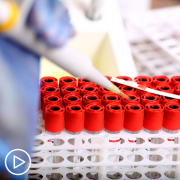What Are the Phases of Myeloma Treatment?
What Are the Phases of Myeloma Treatment? from Patient Empowerment Network on Vimeo.
Myeloma specialist Dr. Mark Schroeder explains the phases of myeloma treatment, defining induction, consolidation, and maintenance therapy for patients with myeloma.
Dr. Mark Schroeder is a hematologist at Siteman Cancer Center of Washington University School of Medicine in St. Louis. Dr. Schroeder serves as Associate Professor in the Department of Medicine. Learn more about Dr. Schroeder.
See More from Engaging in Myeloma Treatment Decisions
Related Resources:

|

|

|
Transcript:
Katherine Banwell:
Let’s talk about the different phases of therapy for myeloma, and I’m going to ask you for some more definitions. What is induction therapy?
Dr. Mark Schroeder:
Induction therapy is the first treatment that we’re starting for myeloma. It’s oftentimes a combination of a number of chemotherapies that our goal is to get control of the cancer quickly, so reduce the burden of the cancer in a patient’s body.
Oftentimes, when patients present with myeloma, that’s when the burden of cancer is the highest. So, induction therapy is a combination often of three or four different drugs given over the course of about three to four months to treat the myeloma and get initial control.
Katherine Banwell:
What about consolidation therapy? What is that?
Dr. Mark Schroeder:
So, after you have had a response to induction therapy, your oncologist might talk about, “Well, let’s deepen that response.” That’s when we think about consolidation. So, it’s going to be poten – most of the time is a change of therapy from the three or four drugs that you were treated for in the myeloma. An example of consolidation would be going through a stem cell transplant or more chemotherapy after stem cell transplant. So, that’s a change in therapy, and it ends up deepening the response, killing more of the cancer.
Katherine Banwell:
And what about maintenance therapy?
Dr. Mark Schroeder:
So, after you have gone through induction, you have control of the myeloma, we’ve deepened that response with consolidation, we know that myeloma is a cancer that tends to come back. And we know from experience that continuing some of the drugs that we used in induction at low doses are effective to try and prevent it from progressing or coming back, and it extends that period of time – and that’s maintenance therapy. It’s using some of the drugs we used to initially treat myeloma at lower doses to continue to suppress low levels of the cancer.










